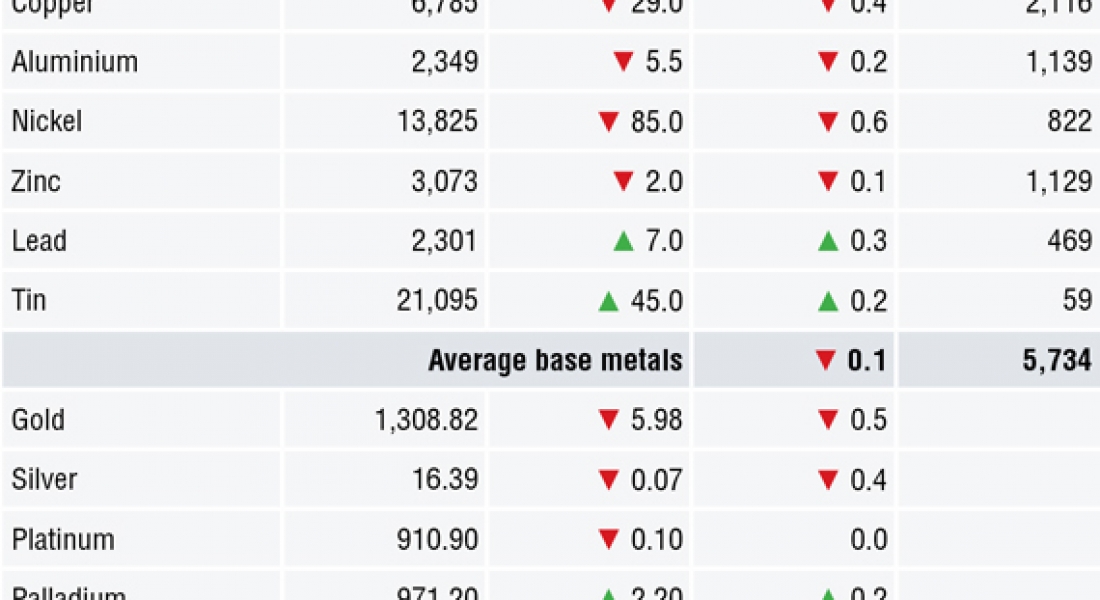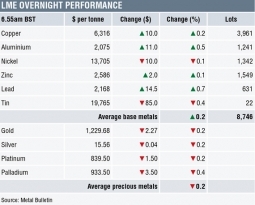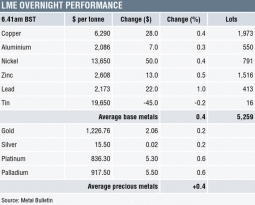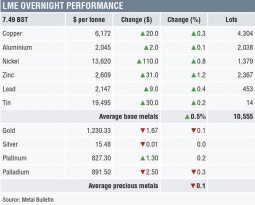Base metals prices on the London Metal Exchange were mixed on the morning of Wednesday May 9, with all the metals, except tin (+0.2%) and lead (+0.3%), down by an average of 0.3%. Copper prices were off 0.4% at $6,785 per tonne.
Volume on the LME has been below average, with 5,734 lots traded as at 07.37 am London time.
This follows on from what turned out to be a generally negative day on Tuesday, when despite most of the metals opening with gains, the complex closed down by an average of 0.3%.
The precious metals were split with losses in gold and silver of 0.5% and 0.4% respectively, with gold at $1,308.82, while platinum prices were little changed and palladium prices were up by 0.2%. Considering the United States is walking away from the Iran nuclear deal, we are surprised gold is not stronger.
Base metals prices on the Shanghai Futures Exchange this morning were for the most part weaker, with the complex down by an average of 0.5%. Lead prices were up by 0.2%, while the rest of the metals were down, with copper prices off by 0.8% at 50,990 yuan ($8,005) per tonne.
Spot copper prices in Changjiang were down by 0.6% at 50,680-50,810 yuan per tonne and the LME/Shanghai copper arbitrage ratio has climbed to 7.51 from 7.49 on Tuesday.
In other metals in China, iron ore prices were down by 0.5% at 470.50 yuan per tonne on the Dalian Commodity Exchange. On the SHFE, steel rebar prices were down by 1.8%, while gold and silver prices were both down by 0.1%.
In wider markets, spot Brent crude oil prices were up by 0.9% at $76.63 per barrel, it would appear the US/Iran development was generally expected. Meanwhile, the yield on US 10-year treasuries was strong at 2.99%, as was the German 10-year bund yield at 0.57%.
Equity markets in Asia were mixed on Wednesday: Nikkei (-0.44%), Hang Seng (+0.15%), CSI 300 (-0.36%), Kospi (-0.24%) and the ASX 200 (+0.26%). This follows a flat to weaker performance in western markets on Tuesday, where in the US the Dow Jones closed little changed at 24,360.21, and in Europe where the Euro Stoxx 50 closed down by 0.18% at 3,557.88.
The dollar index is rallying again, at 93.38 it has extended its gains and has reconfirmed its bull run. Conversely, the other major currencies are weaker: euro (1.1829), sterling (1.3508), the yen (109.63) and the Australian dollar (0.7419). The yuan is also weaker at 6.3747, as are all the emerging market (EM) currencies we follow. The weakness in the EM currencies is a sign that traders are getting nervous about the rising dollar and higher US treasury yields. In this environment it is not surprising that traders are reducing risk exposure.
Economic data out already on Wednesday showed weak UK retail sales and mixed data out of Japan, where average cash earnings climbed 2.1%, having previously climbed 1%, but leading indicators came in at 105%, after a previous reading of 106%. Data out later includes French industrial production, Italian retail sales, with US data including producer price index (PPI), wholesale inventories and crude oil inventories.
The base metals’ recent attempts to rally ran into supply and prices are consolidating once again. The combination of less than bullish economic data, the strong dollar, rising yields, high oil prices and heightened geopolitical tensions, all make for a risk-off climate. As such, we would not be surprised if prices came under more downward pressure. If that is avoided, however, then it will be a sign that demand is not weak, but it will reconfirm our belief that in the current climate consumers feel little need to chase prices higher.
The fact gold prices are down at a time when geopolitical risks have increased, suggests risk-off is affecting all the metals for now. The opportunity cost of holding gold is also higher now that US treasury yields are firmer and the stronger dollar is a headwind too. If higher yields, a stronger dollar and geopolitical tensions start to undermine investor confidence in broader markets, then gold may start to pick up safe-haven buying.



The post METALS MORNING VIEW 09/05: Metals nervous due to stronger dollar; rising yields start to rattle EM currencies appeared first on The Bullion Desk.
Read More
Source: Bullion Desk News









